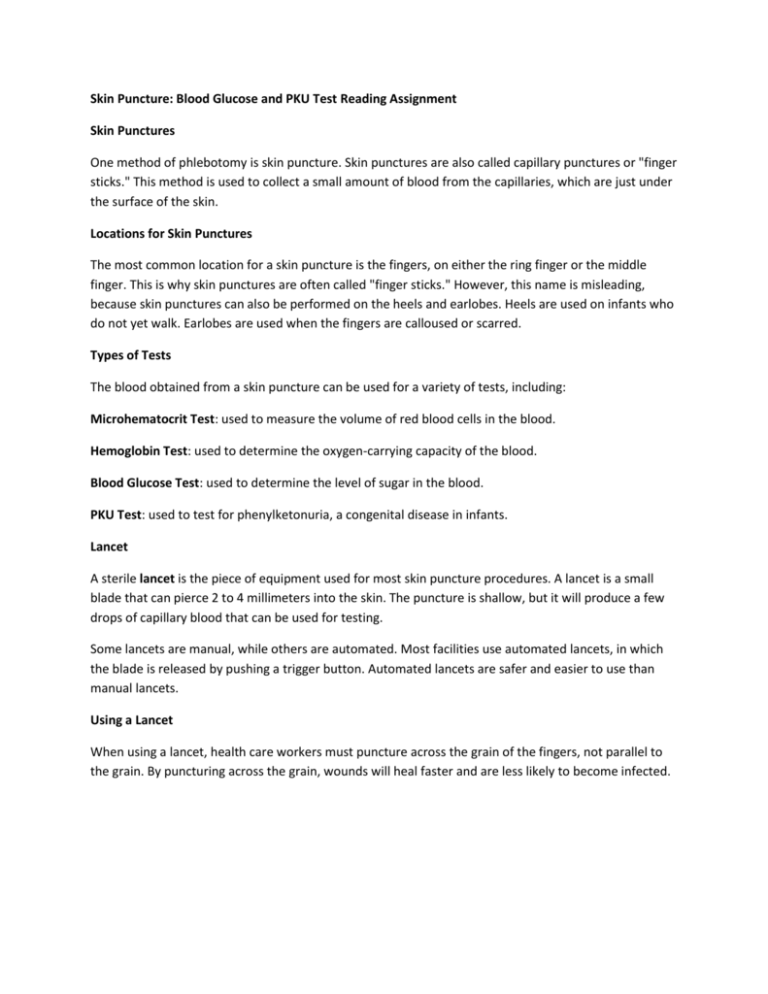Skin-Puncture-Blood-Glucose-and-PKU
advertisement

Skin Puncture: Blood Glucose and PKU Test Reading Assignment Skin Punctures One method of phlebotomy is skin puncture. Skin punctures are also called capillary punctures or "finger sticks." This method is used to collect a small amount of blood from the capillaries, which are just under the surface of the skin. Locations for Skin Punctures The most common location for a skin puncture is the fingers, on either the ring finger or the middle finger. This is why skin punctures are often called "finger sticks." However, this name is misleading, because skin punctures can also be performed on the heels and earlobes. Heels are used on infants who do not yet walk. Earlobes are used when the fingers are calloused or scarred. Types of Tests The blood obtained from a skin puncture can be used for a variety of tests, including: Microhematocrit Test: used to measure the volume of red blood cells in the blood. Hemoglobin Test: used to determine the oxygen-carrying capacity of the blood. Blood Glucose Test: used to determine the level of sugar in the blood. PKU Test: used to test for phenylketonuria, a congenital disease in infants. Lancet A sterile lancet is the piece of equipment used for most skin puncture procedures. A lancet is a small blade that can pierce 2 to 4 millimeters into the skin. The puncture is shallow, but it will produce a few drops of capillary blood that can be used for testing. Some lancets are manual, while others are automated. Most facilities use automated lancets, in which the blade is released by pushing a trigger button. Automated lancets are safer and easier to use than manual lancets. Using a Lancet When using a lancet, health care workers must puncture across the grain of the fingers, not parallel to the grain. By puncturing across the grain, wounds will heal faster and are less likely to become infected. Blood Glucose Glucose is a form of sugar. It is normal for blood to contain a certain amount of glucose. In most cases, a hormone called insulin is able to metabolize the glucose in body cells. However, some people do not produce enough or any insulin. This condition is called diabetes mellitus. People with diabetes must check their blood glucose level several times a day Diabetes Mellitus Diabetes mellitus results when the pancreas does not produce enough insulin. The exact cause is not known. Symptoms include excessive urination, thirst, and hunger. There are two types of diabetes. Type 1 diabetes results when the pancreas does not produce any insulin. This type of diabetes may occur at any age but it is usually diagnosed early in life. Treatment involves the injection of insulin on a regular basis. Type 2 diabetes results when the pancreas produces insulin, but not enough to meet the needs of the body. This type of diabetes is linked with obesity and is most common in adults over the age of 45. Treatment may involve oral medication, exercise, weight loss, and insulin injections. Types of Tests Several types of tests are used to test blood glucose levels. Types of tests include: Fasting blood sugar (FBS) test Glucose tolerance (GTT) test Glycohemoglobin (A1C)test Fasting Blood Sugar Test A fasting blood sugar test (FBS) is a glucose test that is performed after 8 to 12 hours of fasting. Normal fasting blood sugar is 70 to 110 milligrams of glucose per deciliter of blood. Glucose Tolerance Test A glucose tolerance test (GTT) is used to evaluate how well a person metabolizes a specific amount of glucose. This test is often used to diagnose diabetes. In a glucose tolerance test, the patient's blood sugar is tested after 8 to 12 hours of fasting. Then, the patient drinks a specific amount of glucose. The blood glucose level is checked after several elapsed time intervals. If the patient has diabetes, the glucose level will stay the same. Glycohemoglobin Test A glycohemoglobin test measures the amount of glucose that attaches to the hemoglobin. Diabetics should be tested for glycohemoglobin levels once or twice a year. Normal range is 4 to 6 percent. A person with controlled diabetes will average 6 to 7 percent, but a person with uncontrolled diabetes will have a percentage of 10 or higher. (Hemoglobin A1c (HbA1c) is a minor component of hemoglobin to which glucose is bound.) Glucose Meter A glucose meter is the tool most commonly used to measure blood glucose levels. There are many different types of glucose meters on the market today. Some meters require that blood is collected on a testing strip first and then inserted into the meter. However, with other meters, a drop of blood can be placed directly onto a sensor pad on the meter. Be sure to follow the manufacturer's instructions. PKU Phenylketonuria (PKU) is a congenital disease that is caused by a defect in the metabolism of the amino acid, phenylalanine. If phenylalanine is left un-metabolized in an infant, the brain may not develop completely, which will result in mental retardation. Fortunately, PKU can be treated if it is detected in infancy. A simple blood test is used to diagnose PKU. This test is required in most states. PKU Test PKU tests should be performed while the infant is still in the hospital or at the infant's first doctor visit. A PKU test is performed by putting blood samples from the infant's heel on a PKU form. The forms are provided by the state's Department of Health. After the blood is put on the form, it should be mailed to the Department of Health, who will analyze the blood and notify the physician of the results.






